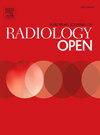动态增强MRI在直肠癌急性放射性直肠损伤诊断中的价值:与内镜的比较
IF 2.9
Q3 RADIOLOGY, NUCLEAR MEDICINE & MEDICAL IMAGING
引用次数: 0
摘要
目的探讨动态对比增强MRI (DCE-MRI)定量参数对直肠癌急性放射性直肠损伤(RRI)的诊断价值。方法回顾性研究纳入2014年11月至2022年7月新辅助放化疗后行直肠MRI(包括DCE-MRI序列)和内镜检查的确诊直肠癌患者。根据维也纳直肠镜评分将入组患者分为急性RRI组和非急性RRI组。两名放射科医师独立测量了DCE-MRI定量参数(包括正向体积传递常数[Ktrans]、速率常数[keep]、血管外细胞外空间体积分数[ve])和直肠壁厚度。进行受试者工作特征曲线分析,分析具有统计学意义的参数。结果纳入49例患者(中位年龄58岁,四分位间距14岁,男性34例),其中28例为急性RRI组。急性RRI患者的Ktrans明显低于非急性RRI患者(0.049 min−1 vs 0.107 min−1;P <; 0.001)。Ktrans的受者工作特性曲线下面积为0.80。Ktrans截止值为0.079 min−1,敏感性和特异性分别为93 %和67 %。结论ktrans在诊断急性RRI方面表现中等,为直肠癌急性RRI患者的管理和治疗提供了无创、客观的依据。本文章由计算机程序翻译,如有差异,请以英文原文为准。
Value of dynamic contrast-enhanced MRI in the diagnosis of acute radiation-induced rectal injury in patients with rectal cancer: A comparison with endoscopy
Objectives
To investigate the diagnostic value of dynamic contrast-enhanced MRI (DCE-MRI) quantitative parameters in acute radiation-induced rectal injury (RRI) among patients with rectal cancer.
Methods
This retrospective study included patients confirmed to rectal cancer who underwent rectal MRI (including a DCE-MRI sequence) and endoscopy after neoadjuvant chemoradiotherapy from November 2014 to July 2022. The enrolled patients were divided into an acute RRI group and a non-acute RRI group based on Vienna rectoscopy score. Two radiologists independently measured DCE-MRI quantitative parameters (including the forward volume transfer constant [Ktrans], rate constant [kep], and fractional extravascular extracellular space volume [ve]) and thickness of rectal wall. Receiver operating characteristic curve analysis was performed to analyze statistically significant parameters.
Results
Forty-nine patients (median age, 58 years; interquartile range, 14 years; 34 men) were enrolled, 28 of whom were in the acute RRI group. Ktrans in patients with acute RRI was significantly lower compared to those without acute RRI (0.049 min−1 vs 0.107 min−1; P < 0.001). The area under the receiver operating characteristic curve of Ktrans was 0.80. With a Ktrans cutoff value of 0.079 min−1, the sensitivity and specificity were 93 % and 67 %, respectively.
Conclusion
Ktrans demonstrated moderate performance in diagnosing acute RRI, providing a non-invasive and objective basis for managing and treating rectal cancer patients with acute RRI.
求助全文
通过发布文献求助,成功后即可免费获取论文全文。
去求助
来源期刊

European Journal of Radiology Open
Medicine-Radiology, Nuclear Medicine and Imaging
CiteScore
4.10
自引率
5.00%
发文量
55
审稿时长
51 days
 求助内容:
求助内容: 应助结果提醒方式:
应助结果提醒方式:


